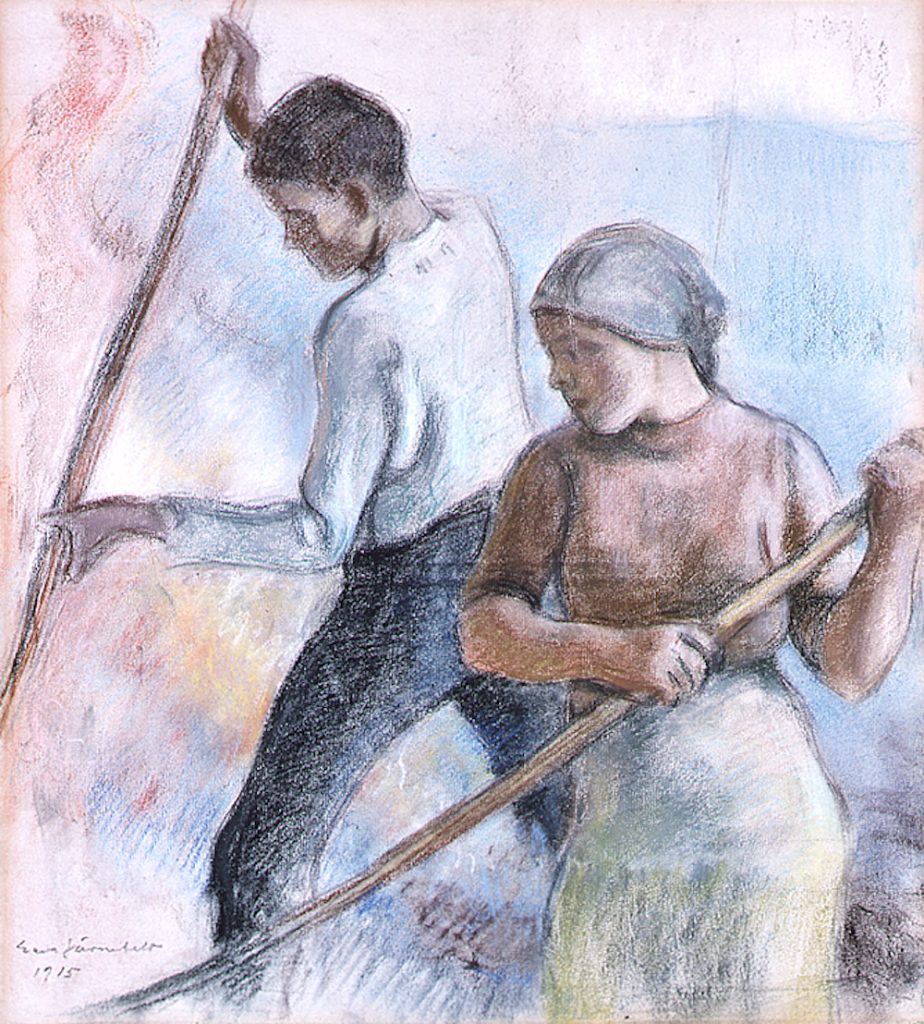Eero Järnefelt, Burn-beaters, 1915
Eero Järnefelt, who is among the central names of the Golden Age of Finnish art, carried out numerous artworks with a burn-beating theme. This is also the theme of the painting Kaskenpolttajat (Burn-beaters) (1915) which is in the collection of the Gösta Serlachius Fine Arts Foundation.
Erik Nikolai (“Eero”) Järnefelt (1863–1937) was born into a Vyborg family of noble descent, which especially on the maternal side was full of artistic talent. The family, which often moved due to the father’s occupation, had very wide cultural interests, from literature to music and from visual arts to theatre. This most certainly played a part in the career choices of the children. Of the artist Eero’s brothers, Armas was a composer and conductor, Arvid a writer and Kasper a critic. The brothers’ circle of friends included some of the central cultural figures of the period, such as J. H. and Eero Erkko, Juhani Aho and Jean Sibelius, who married the Järnefelt brothers’ sister, Aino.
The Järnefelts spent their summers in different parts of Finland. The father of the family, Alexander Järnefelt, wanted his children to acquaint themselves with the different regions and dialects of their home country. The summer of 1889, the family spent in Kolho, a village of Keuruu. From this summer stem some of Eero Järnefelt’s most renowned paintings, such as Pyykkiranta (Laundry on the Shore) and Kesäyön kuu (Summer Night Moon). With their friends, the Järnefelts also made a summer trip to the Seppälä farm in Mänttä, where the fennoman E. I. Roini lived.
From the summer of 1893 stems one of Järnefelts most well-known paintings Kaski (Raatajat rahanalaiset) (Burn-beating (Serfs under Money)). The painter spent the summer of 1893 at Väisälänmäki in Lapinlahti, in a house by the shore called Ranta-Puurula. He photographed the local people and used them as models for his painting. The artist had, however, been interested in the burn-beating motif even before this, which you can see for example in the painting Kaskenpolttajat (1891).
Burn-beaters, which belongs to the collection of the Gösta Serlachius Fine Arts Foundation, bears the same motif. The work which has been carried out in pastel technique on paper is from 1915, which means it represents the later phase in Järnefelt’s production. In his Järnefelt monography, Ludvig Wennervirta points out that burn-beating was one of the themes that “interested Järnefelt during his whole lifetime”. As one example of this, Wennervirta takes precisely this “largish pastel painting” belonging to the Gösta Serlachius collection.
Burn-beating was an essential part of Finnish agriculture, and it’s considered to be serving as an example also of the transition period of our country’s forestry. Ville Lukkarinen has directed our attention to how, at the end of the 19th century, “it was now possible to think of the forest as an economic resource, as economy forest, and precisely the traditional farming method of burn-beating, along with tar burning, was the most wasteful way of using this commodity”. This being the case, burn-beating by and by passed into history. According to the writer Kauppis-Heikki, Eero Järnefelt also realized this, at least by the time he was at Väisälänmäki: “The artist, spending his summer by this sloping shore and seeing those workers doing their work in the heat, immediately realized that this belongs to the Finnish agricultural history and must be eternalized.” More than 20 years later, the theme still held Järnefelt in its grip.
Tomi Moisio
Curator
Sources:
Kauppis-Heikki. Muistelma. Nuori Suomi 1913.
Lindqvist, Leena (ed.). Taiteilijan tiellä Eero Järnefelt. Helsinki: Otava, 2002.
Lukkarinen, Ville. Moni-ilmeinen erämaa – vuosisadan vaihteen taiteilijat Suomen metsissä. Järvenpää, 1999
Wennervirta, L. Eero Järnefelt ja hänen aikansa 1863–1937. Helsinki: Otava, 1950.


